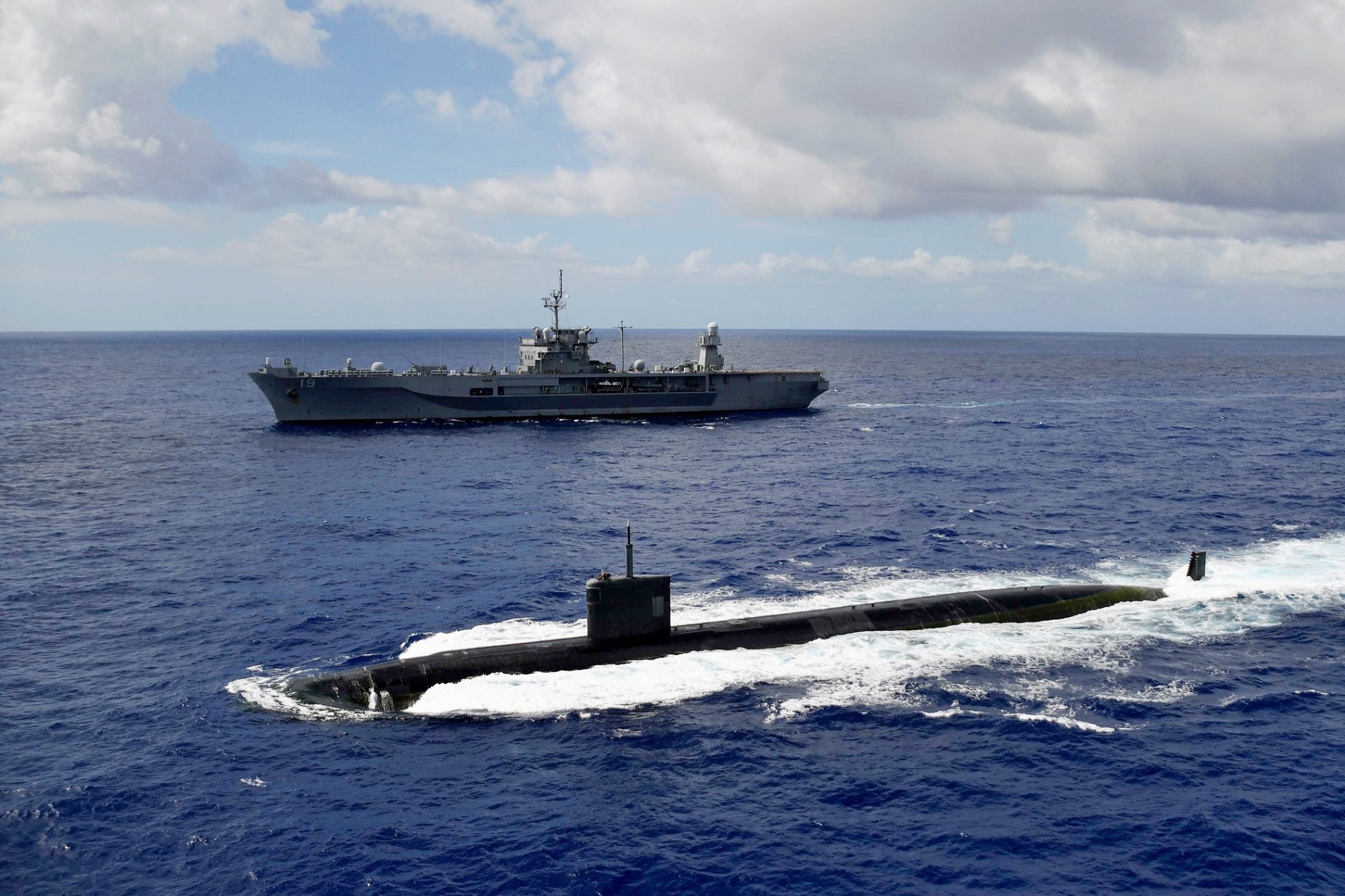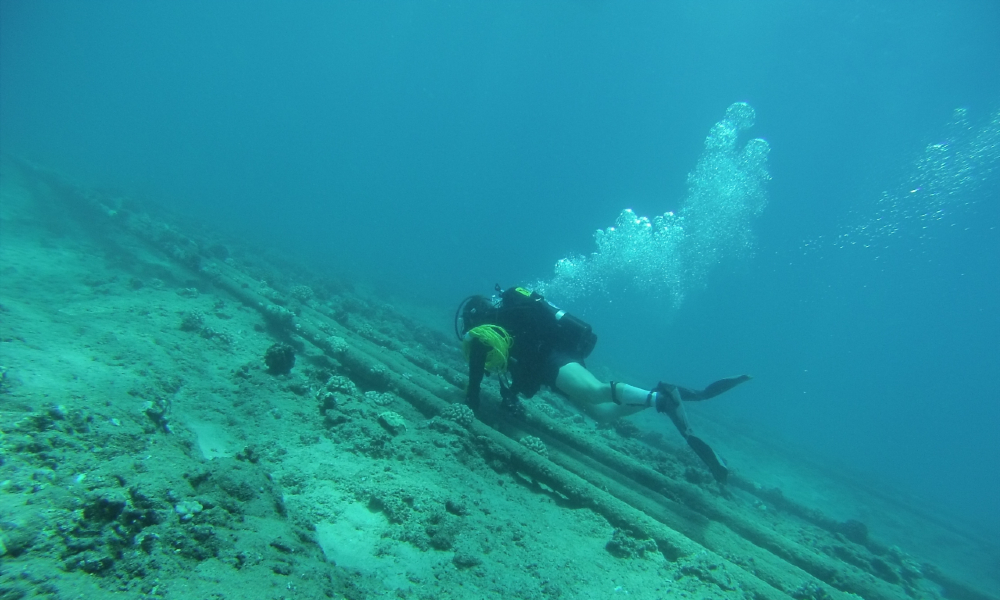Water Wars: The Pandemic’s Great Power Competition at Sea
Chinese aggression and a ubiquitous U.S. military are becoming the new normal for the pandemic’s “great power competition” in the Indo-Pacific.

Published by The Lawfare Institute
in Cooperation With

As the world continues its fight against the coronavirus, the U.S. and Chinese militaries are testing each other’s limits in the Indo-Pacific region. Beijing is bristling at its neighbors, engaging in aggressive behavior while most countries are preoccupied with the pandemic. In response, the Pentagon is operating in overdrive to show Beijing that the U.S. military remains ready—on, above and below the Pacific.
At sea, three U.S. carrier strike groups were underway in the Pacific by mid-June: USS Nimitz (CVN 68) operated in the Eastern Pacific, while USS Ronald Reagan (CVN 76) and USS Theodore Roosevelt (CVN 71) sailed in the Western Pacific.
In the air, an expanded and well-advertised military presence has been flying across the region. On April 30, two U.S. B-1 bombers flew a 32-hour round-trip mission from South Dakota to the South China Sea. The next day, four U.S. B-1 bombers returned to Guam for “strategic deterrence missions” in the Indo-Pacific region. The U.S. Air Force said that the bomber task force serves to provide “operational unpredictability,” two weeks after ending 16 years of continuous bomber presence on Guam. The unpredictability of U.S. bombers on the island serves to complicate Chinese military planning in a wartime contingency. Then, on June 9, a U.S. military C-40A transport plane flew over Taiwan, with permission from the Taiwanese government. Chinese Su-30 Flankers briefly entered Taiwan’s Air Defense Identification Zone (ADIZ) soon afterward.
Below the sea, U.S. submarines have further confounded Chinese operations. An unusual Pacific Fleet statement on May 8 stated that “every one of its forward-deployed submarines [was] conducting contingency response operations at sea in the Western Pacific, in support of a free and open Indo-Pacific region amidst the pandemic caused by the coronavirus.” Submarines operate on the basis of stealth. Advertising that they are all deployed—somewhere in the Western Pacific—sends a signal for deterrence: The U.S. Navy is present in the region, even when unseen.
The increased U.S. operational tempo seems to be a response to aggressive Chinese actions around the periphery of the People’s Republic of China (PRC). In the last three months alone, the PRC has rammed Vietnamese fishing boats on two separate occasions in the South China Sea; established two new districts in “Sansha City” on Woody Island to assert jurisdiction over the PRC’s South China Sea territorial claims; “located” and named 80 "islands" in the South China Sea, despite many being underwater seamounts and within Vietnam’s exclusive economic zone (EEZ); directed fire control radar at a Philippine Navy vessel near a Philippine-occupied reef; harassed a Malaysia-hired drill ship operating in Malaysia’s own EEZ; and fought a border skirmish in the Galwan Valley that killed 20 Indian soldiers.
Much like the United States, China is eager to show that its navy remains ready despite the coronavirus pandemic. Earlier in April, China’s Liaoning (CV 16) aircraft carrier task group passed through the Miyako Strait twice. The second transit was only the fifth time the Liaoning has ever transited the Miyako Strait—a strategic chokepoint in the “first island chain,” which separates the Chinese People’s Liberation Army (PLA) Navy in the East China Sea from the greater Pacific. Chinese state-run media reported that the Liaoning’s operations included “back-to-back attack-defense mock battles in the South China Sea.” It added that the exercises came at a time when the U.S. Navy was increasingly present in the South China Sea but “struggling to deal with multiple COVID-19 outbreaks.”
During the Liaoning’s South China Sea operations, a Chinese escort ship maneuvered in an "unsafe and unprofessional way" near the USS Mustin (DDG 89), according to the Pentagon. U.S. Deputy Assistant Secretary of Defense for South and Southeast Asia Reed Werner added that Chinese fighter jets have harassed U.S. reconnaissance aircraft “at least nine times” in the South China Sea since mid-March. Werner called the trendline of U.S.-China military interactions “very worrisome” and added that “[w]e continue to see Chinese destabilizing behavior in the South China Sea” during the pandemic.
A particularly tense standoff occurred over Malaysia’s oil drilling in its South China Sea EEZ. Under contract to Malaysia’s state oil company Petronas, the drillship West Capella began exploring for minerals off of Borneo in October 2019. China Coast Guard vessels escorting the PRC-government survey ship Haiyang Dizhi 8 began harassing West Capella this April. The U.S. State Department called China’s actions “bullying behavior,” prompting the United States and Australia to send several naval vessels to the area. A few weeks later, the United States also submitted a letter to the U.N. protesting the excessive maritime claims China articulated in its response to Malaysia’s December 2019 submission to the Commission on the Limits of the Continental Shelf.
Bonnie Glaser from the Center for Strategic and International Studies surmised that the U.S. military’s high operational tempo is “an effort by the United States to signal [to] China that it should not miscalculate” about U.S. military preparedness during the coronavirus pandemic. Getting coronavirus-free naval crews underway also diminishes the risk that the virus poses for military readiness. In response to the three U.S. carrier strike groups, Chinese Communist Party (CCP) mouthpiece the Global Times quoted a Chinese naval expert who stated that “the US military only cares whether they are deployed rather than if they are ready to fight[,]” and it was “also possible that another COVID-19 outbreak will take place on the US carriers.” The article also reminded readers that “China possesses aircraft carrier killer weapons like the DF-21D and DF-26 anti-ship ballistic missiles.”
Freedom of Navigation Operations
U.S. freedom of navigation operations (FONOPs) in the South China Sea have also continued apace over the past two months. On April 28, USS Barry (DDG 52) executed a FONOP near the Paracel Islands (Mandarin: Xisha Qundao; Vietnamese: Quần đảo Hoàng Sa). The PLA Southern Theater Command said that the FONOP “seriously violated China’s sovereignty and security interests, deliberately increased regional security risks and could easily trigger an unexpected incident.” U.S. vessels routinely enter the waters near the Paracel Islands to challenge what the United States deems to be an excessive straight baseline around the island chain in violation of the U.N. Convention on the Law of the Sea (UNCLOS). The United States asserts that UNCLOS does not allow a coastal state like the PRC to use straight baselines around islands of an offshore archipelago; only archipelagic states such as the Philippines and Indonesia, which consist entirely of islands, can do so. The 2016 Permanent Court of Arbitration’s (PCA’s) South China Sea award supported that understanding of UNCLOS. China refused to participate in the PCA’s proceedings and rejected the entire ruling as “invalid and non-binding.”
The day after the Barry FONOP, the USS Bunker Hill (CG 52) conducted a FONOP through the South China Sea’s Spratly Island chain. The Seventh Fleet said the Bunker Hill conducted innocent passage within the 12-nautical mile territorial seas of PRC-occupied Gaven Reefs (Mandarin: Nanxun Jiao; Vietnamese: Đá Ga Ven; Tagalog: Burgos). Article 19 of UNCLOS guarantees the right of innocent passage for warships within the territorial sea without any prior notice or permission. The PCA’s South China Sea Arbitration concluded that Gaven Reef (North) was a rock garnering a 12-nautical mile territorial sea (that is, a high-tide feature “incapable, in its natural condition, of sustaining human habitation or an economic life of its own”). The Seventh Fleet statement said that Bunker Hill’s innocent passage FONOP challenged China, Vietnam and Taiwan’s “prior notification” or permission requirements for a warship transiting through a territorial sea. Despite also claiming Gaven Reefs, the Philippines was noticeably absent from the Seventh Fleet’s FONOP statement challenging “unlawful restrictions,” likely because the Philippines supports a warship’s right of innocent passage.
The USS Mustin then conducted a FONOP in the Paracel Islands on May 28. A U.S. defense official told CNN that the Mustin sailed within 12 nautical miles of PRC-occupied Woody Island (Mandarin: Yongxing Dao; Vietnamese: Đảo Phú Lâm) and Pyramid Rock (Mandarin: Gaojian Shi; Vietnamese: Hòn Tháp). A Seventh Fleet spokesman said that the Mustin’s transit “demonstrated that these waters are beyond what China can lawfully claim as its territorial sea," presumably referring to the straight baseline around the Paracel Islands. Much like its other FONOP commentary, the Global Times reported that Chinese forces “expelled” the Mustin from the Parcels, adding that the FONOP “seriously sabotaged peace and stability in the South China Sea” and justified China’s 6.6-percent increase in its 2020 defense budget.
Taiwan
On May 13, the USS McCampbell (DDG 85) transited the Taiwan Strait a week before the inauguration of Taiwanese President Tsai Ing-wen’s second term. Then on June 4—the 31st anniversary of the 1989 Tiananmen Square massacre—the USS Russell (DDG 59) also transited the Taiwan Strait. It was the seventh U.S. Navy transit through the high-seas waterway between Taiwan and the PRC this year, compared to nine total transits in all of 2019. The USS Barry completed Taiwan Strait transits twice in April 2020 alone. The Global Times reported on the USS Russell’s transit with thinly veiled displeasure, casting the passage as “a provocation to the Chinese mainland” and an attempt by President Trump to distract the public from U.S. domestic issues. The Global Times then cited “recent reports” that the PLA “continuously” holds amphibious landing drills that include “amphibious tanks storming the beaches [and] civilian ships transporting tanks and armored vehicles across the sea.”
The PLA is set to conduct large-scale exercises in the South China Sea later this summer, to include at least one of China’s aircraft carriers and a beach-landing exercises near Hainan Island. The Japan Times reported that the landing drill serves to simulate the seizure of Taiwan-held Pratas Islands (Mandarin: Dongsha Qundao). The Japan Times also said that the PLA Southern Theater Command will mobilize “an unprecedented level of … marines, landing ships, hovercrafts and helicopters” for the exercise. A Taiwanese general said that the Taiwan Defense Ministry is monitoring movements of “hostile forces,” and the ministry has contingency plans for the disputed waters.
In Other News...
Washington’s China Moves
On April 16, Rep. Mac Thornberry of the House Armed Services Committee unveiled the “Indo-Pacific Deterrence Initiative” to counter PRC belligerence. Legislators modeled the initiative off the 2014 European Deterrence Initiative, which was created to counter Russia. If passed, the Indo-Pacific Deterrence Initiative will allocate $6 billion for measures that aim to deter China from altering the status quo in the region. The fund will include “missile defense, intelligence activities, the prepositioning of equipment, troop rotations, military construction, work with allies and partners, and training exercises.”
Reflecting Thornberry’s legislation, Sens. Jim Inhofe and Jack Reed intend to establish what they call the “Pacific Deterrence Initiative” through the National Defense Authorization Act for fiscal 2021. They similarly seek to deter China and reassure U.S. allies and partners of Washington’s commitment to the region. Michèle Flournoy—former defense undersecretary in the Obama administration and probable secretary of defense in a Joe Biden administration—bolstered their argument, arguing in Foreign Affairs that the best U.S. approach to China is investing in a retooled deterrence strategy.
On May 20, the White House released the “United States Strategic Approach to the People’s Republic of China” to little fanfare. Despite the meager press coverage amid the coronavirus pandemic and George Floyd protests, the document is expansive in articulating “numerous challenges” that the PRC poses to U.S. national interests. The report classifies these challenges as economic, security and values based. The report states that China is “engaging in provocative and coercive military and paramilitary activities in the Yellow Sea, the East and South China Seas, the Taiwan Strait, and Sino-Indian border areas.”
Saga of the Theodore Roosevelt
The USS Theodore Roosevelt’s return to sea on May 21 occurred after a coronavirus outbreak kept the aircraft carrier in port on Guam for nearly two months. In the outbreak, 1,156 crew members tested positive for the coronavirus and one sailor died. The leaked memorandum about the U.S. Navy’s slow response to the coronavirus from then-commanding officer of the Theodore Roosevelt Capt. Brett Crozier led to his firing and the ignominious resignation of Acting Secretary of the Navy Thomas Modly.
The U.S. Navy’s official investigation released on June 19 attributed the outbreak on the Theodore Roosevelt to a March port visit in Da Nang, Vietnam—a visit that Indo-Pacific Command (INDOPACOM) Commander Adm. Philip Davidson approved. However, the report blames Crozier’s handling of the crisis, and the Navy will not reinstate Crozier as the commanding officer of the Theodore Roosevelt. Sailors aboard the Theodore Roosevelt first showed symptoms of COVID-19, the respiratory disease caused by the novel coronavirus, approximately 16 days after possible crew exposure in Da Nang, causing some military officials to assert that the virus spread via carrier on-board delivery (COD) flights from Vietnam, Japan or the Philippines, rather than the port visit. The incubation period for COVID-19 is two weeks.
The Navy investigation concludes that two of the Navy’s recent determinations are sound: Crozier should not be in command, and port visits cause coronavirus outbreaks. The Navy recently curtailed port visits for other ships during the pandemic. But the investigation’s conclusions and the fallout for the implicated officers appear contradictory. If the report is correct and the Vietnam port visit caused the outbreak, then INDOPACOM and other officials high above Crozier put the carrier at risk in deciding to proceed with the visit, so the career-ending punishment for Crozier seems unwarranted. If the report is incorrect and COD flights are to blame for the virus, then Crozier was more at fault. Yet that inconvenient conclusion would be worrisome for sustained naval readiness and implies that restricting port visits alone will not prevent future shipboard coronavirus infections.
The Navy seems to be setting another precedent in the Pacific of sending ships into harm’s way, and then blaming commanding officers when there are casualties. Mayors, governors and presidents cannot control coronavirus outbreaks in their expansive jurisdictions; how fair is it to blame a commanding officer for an outbreak when 5,000 people are stacked on top of each other, all in a steel container the size of three football fields? In response to the Navy’s report, the House Armed Services Committee is launching its own investigation into the coronavirus outbreak aboard the Theodore Roosevelt.
Analysis
At the Hoover Institution, U.S. law professors John Yoo and Robert Delahunty argue that Washington should rebuild its political and military relations with Taiwan, rather than bend to Chinese pressure as U.S.-China relations worsen. They contend that Taiwan lies at a “vital strategic position” and would pose a “serious strategic blow” if the CCP took control of the island. “Beijing would gain an advanced economy, a base for its thousands of ballistic missiles, and a deep-water port from which to project power into the midst of America’s regional allies,” Yoo and Delahunty write. Moreover, they argue that an independent Taiwan serves as a “symbol of a free Chinese people” and “the model for a future unified and democratic China.”
At the New York Times, correspondents Edward Wong and Michael Crowley called President Trump the “biggest obstacle” to America’s China policy. The authors assert that Trump himself undermined the administration’s efforts to frame U.S.-China relations as a form of “great power competition,” as outlined in the most recent National Security Strategy.
Wong and Crowley’s analysis draws heavily from former National Security Adviser John Bolton’s new book. In describing U.S.-China policy under Trump, Bolton writes that “Trump’s conversations with Xi reflected not only the incoherence in his trade policy but also the confluence in Trump’s mind of his own political interests and U.S. national interests.” Bolton’s book itself does not recount U.S.-China maritime conflict in detail but does mention a conversation with Trump regarding “the Chinese threat to bring nearly the entire South China Sea under its sovereignty.”





